Sharlyn J. Lauby's Blog, page 66
July 1, 2021
Wellbeing Programs Must Address Employee Workloads

Estimated reading time: 4 minutes
Over the past couple of months, there’s been more than a few articles about employees being stressed and burned out. Issues related to employee wellbeing. It started with a group of first-year analysts at Goldman Sachs talking about their difficult working conditions, including being so overworked that they didn’t have time to bathe. Yes, you read that correctly. Let me just say what you’re probably thinking – that is just all kinds of wrong.
I totally understand that there are some jobs that pay extraordinarily high wages and along with it comes giving up some of your personal life. But not having time to bathe doesn’t and shouldn’t fall into that category.
The World Health Organization (WHO) and the International Labor Organization (ILO) recently released a report about the health impacts of individuals who routinely work 55+ hours per week. The report indicated that individuals who regularly work long hours are more susceptible to heart disease (17%) and stroke (35%). The report estimates that 5% of deaths are related to changes in behavior – like unhealthy diet, poor sleep, and reduced activity – because of work demands. I’m not a doctor but I assume the logic goes something like this: Bad habits = Poor health = Risk of death.
One of the reasons that the number of hours we’re working is gaining attention is because more of us are doing it. The WHO and ILO report says about 10% of the global population regularly works long hours. And I can only imagine that this number is growing given all the reports about organizations not being able to find employees to fill jobs. The work still needs to get done. Organizations might be probably are pushing employees a little a lot harder to get things back to a post-pandemic normal.
But I think this is where organizations need to pause for a moment and think about the long-term impact of their actions. Organizations that are focused on economic recovery want and need a high performing workforce. Stress has an impact on delivering that performance. In their 2021 Leadership Transitions Report, global leadership consulting firm DDI mentions that a leader’s level of stress can have a negative impact on their confidence and performance. And I’ve said it before and will say it again, I’ve never seen a stressed-out manager with a calm team. Stress has a tendency to impact the entire organization.
It’s in an organization’s best interest to address workload as part of their wellbeing initiatives. Now, I can hear some senior managers saying, “I’d love to not overwork employees. But it’s impossible. We need employees to put in the extra hours. We have orders to get out.” I hear ya. That’s why I’d like to suggest that you let employees have some control over their workload. Managers can make this possible.
Let employees choose the days they want to put in extra time. And the hours they’re available. Maybe even the location that they work the extra hours. It doesn’t change the fact that employees are working more. But when they can do it on their terms, it makes a difference. Every employee has their own priorities. Many employees are okay with working extra if their priorities are met.
Then, when staffing levels are more manageable, organizations need to make good on their promises to give employees time off. Many times, companies promise that “things will change” once staffing levels are normal again … and then they don’t. Employees will remember when an organization doesn’t deliver on their promises. And now more than ever, when an increasing number of employees are saying “I quit.”, companies need to sincerely demonstrate that they value employee health and wellbeing.
Employee wellbeing isn’t a nice to have HR program. It’s a business imperative. And if businesses want to maintain the high performance it takes to stay competitive, then they need to keep their employees healthy. That includes giving them a manageable workload.
The post Wellbeing Programs Must Address Employee Workloads appeared first on hr bartender.






June 29, 2021
Hybrid Workplaces May Be a Transition Plan We All Need

I’ve written several times about the benefits and challenges of implementing a hybrid workforce. And I still believe that it’s true that employees want flexibility. They wanted flexibility before the pandemic, and they want it now. Creating a hybrid workforce isn’t easy. It involves looking at the current operation and making sure that employees can still maintain productivity and perform at a high level.
But there are some organizations that are anxious to “bring everyone onsite”. I get it. There are employees who loathe remote work. I understand.
I came across an article on Vice recently titled “People Aren’t ‘Addicted’ to Wearing Masks, They’re Traumatized”. It’s a good read and an important reminder that many of our employees have lost a family member or loved one over the past year. Many of our employees have experienced COVID-19 firsthand. While we might want to start normalizing our lives, many employees are still processing the emotional toll of the past year.
Which brings me back to the hybrid workforce. Even if your organization is one of those places that’s ready to start welcoming employees onsite, think about whether the principles of hybrid work could play a key role in the transition.
The Boston Globe had a great article titled “The Hybrid Workplace Probably Won’t Last”. We can debate all day whether or not the author is right. That wasn’t my takeaway. The workplace evolves all the time. Look how much its evolved over the past decade or so. The hybrid workplace may just be what we need to transition in a safe way. It will help employees and therefore, help the organization. So even if your organization doesn’t love the hybrid work model as a long-term strategy, that doesn’t mean it wouldn’t make a good transition plan.
This is all about trust. Employees want to feel safe at work. And organizations can help employees transition to a next normal by building on the trust relationship. Our friends at the Workforce Institute published some research on the subject of trust in the workplace. Here are a couple of key findings:
63% of employees and business leaders say trust must be earned.Over half of employees say that trust directly impacts their: sense of belonging (64%), career choices (58%), mental health (55%), and daily effort (68%).Organizations are very focused on economic recovery right now and I totally recognize that. The best way to make that happen is by having employees who are ready to deliver high performance. Employees will do that when they feel safe and have the tools to do the job. Think about the best plan for making that happen.
Image captured by Sharlyn Lauby after speaking at the SHRM Annual Conference in Las Vegas, NV
The post Hybrid Workplaces May Be a Transition Plan We All Need appeared first on hr bartender.






June 27, 2021
My Brother Plagiarized My Resume – Ask #HR Bartender

Estimated reading time: 3 minutes
This is quite the awkward situation.
Hi, I would like to find out how to report my brother for plagiarism. My resume has specifics about my work personality, key skills, and extracurricular activities that he has copied and pasted onto his own resume and claimed them to be his qualities. I have confronted him about this, and it has ended in him making nasty comments about me. At the end of the day, it is still my words that he has taken and lied about, and I wish to do something about this.
First, let’s address the plagiarism issue. Surprisingly, I’ve received this question before. In the article “Someone Plagiarized My Resume”, I talk with an attorney, a career expert, a resume writer, and a recruiter about some strategies for handing this exact type of situation. I hope you’ll check it out.
Second, I want to offer some resources about what to include (and not include) in your resume. I haven’t seen this reader’s resume, but I’ve always felt that a resume should be a summary of a person’s experience and there are things better saved for the interview.
11 Things You Shouldn’t Include on Your Resume
This article from the Indeed blog is a great reminder that our resume should be focused on work related activities. Information related to our age, hobbies, or interests isn’t necessary.
10 Personal Traits to Include on Your Resume
In crafting your resume, it’s important to show proven experience and professional attributes. This article, also from the Indeed blog, offers some suggestions of the personal traits employers might find valuable.
Third, our presence on LinkedIn is closely tied to our resume. Here are a couple of articles that could be helpful in updating your LinkedIn profile.
Should You Use Your Real Job Title on LinkedIn
This article showcases the recommendations of a group of recruiters on whether having your official job title listed on your LinkedIn profile is a good strategy.
LinkedIn Reactions Expand Professional Communication
While today’s reader question is about resumes, sometimes the best way to get eyes on your qualifications is through networking and good communication. This article talks about LinkedIn Reactions and how to use them successfully.
I hope these articles are valuable in making your resume and LinkedIn profile unique and a good representation of your experience and expertise. There’s one last point that I want to address and that’s the reader’s comment about the person who plagiarized their resume being a family member. I’m totally unqualified to dispense any advice about family disputes, so I won’t.
But I do understand the frustration and disappointment of finding out someone copied something you wrote. Especially something very personal, like a resume. I wish I could say there are magic words to make the situation heal itself, but I’m not sure there are. When I’m in situations like this, I tend to focus my energies on the things I can control – like my own resume. Because someone might be able to take my words, but they can’t duplicate me. Hope that helps.
Image captured by Sharlyn Lauby at the 34th Street Graffiti Wall in Gainesville, FL
The post My Brother Plagiarized My Resume – Ask #HR Bartender appeared first on hr bartender.






June 24, 2021
When Should You Send and Answer Work Emails – Ask #HR Bartender
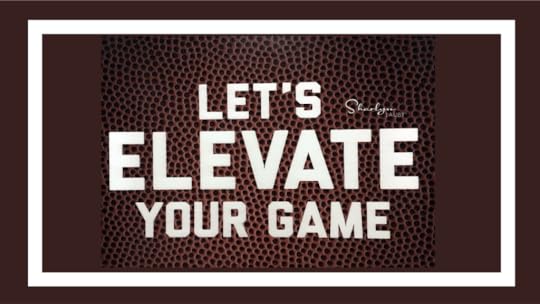
Estimated reading time: 4 minutes
Regular readers of HR Bartender know that I try to answer work-related questions. I will admit that I can’t always answer them right away, but I do work to answer them. To those of you who have sent me questions, thanks so much for being patient!
The reason I’m bringing this up is because the other day I was reading someone’s response to a question that I’ve never been asked before. Here’s the question:
I’ve been trying to maintain a healthy work-life balance, which means closing my work laptop at 5:30p. However, my manager has a tendency to email me in the evenings. Can I wait until the morning to email them back?
The person who answered this question said that the employee should absolutely put their wellbeing first and suggested they take a look at the manager’s email to make sure that it wasn’t time sensitive. I totally agree with the spirit of this reply, but I wanted to take a moment to offer some additional details.
I remember seeing a survey from the Society for Human Resource Management (SHRM) that said the greatest challenge for global teams was collaborating and scheduling work across multiple time zones. As we become a more global business environment, we need to realize that at any given moment in time, we could send or get an email at the end of our workday from a colleague who is just starting theirs. This isn’t bad or wrong. It’s just part of today’s work environment.
Know the best way to communicate. I recently published a post on “Understanding the Best Way to Communicate” that covers the advantages and disadvantages to texting, email, video calls, and face-to-face communication. We’ve all met someone who sent an email that should have been delivered in person. Or held a meeting that should have been an email. Give employees some guidance on using the right communication medium.
Organizations should define email expectations during onboarding. And stick to them. In the employee’s note above, there’s no mention of what company expectations are regarding email. This doesn’t have to be a complicated policy. Let employees know that their wellbeing is important, and they’re not required to answer emails when they’re finished working. This doesn’t stop anyone from sending an email. But this way, employees don’t have to guess what they’re supposed to be doing.
Managers should let employees know when they need to deviate from the email standard. There might be times when a manager needs to communicate with employees outside of the company’s regular policy. For example, maybe the manager will be working late on a project and need information from an employee. They could reach out to that employee and say, “I’m going to be putting the finishing touches on the client proposal, would you be available via email tonight if I have any last-minute questions?”
Employees should let their managers know when they need to deviate from the email standard. The same is true for employees – at every level – when it comes to email responses. It’s possible that an employee might need to let everyone know when they will be difficult to reach. For instance, an employee might tell their co-workers, “I’m going to be unavailable tomorrow afternoon. So, if you send me something, I’ll respond in the evening.” It sets the level of expectation for a reply.
One of the first rules of communication is understand your audience. That includes setting the right level of expectation with them. I don’t know that we’re going to be able to stop people from sending emails in the evening hours. But we can let others know that they don’t need to look at them. Or ask for their cooperation when we need them to read them outside of the norm.
Employees should be able to close their laptops and enjoy their evening. That happens when effective communication take place.
Image captured by Sharlyn Lauby after speaking at the SHRM Annual Conference in Las Vegas, NV
The post When Should You Send and Answer Work Emails – Ask #HR Bartender appeared first on hr bartender.






June 22, 2021
Employers and Employees are Responsible for Retention

Estimated reading time: 3 minutes
I saw a statement being shared around social media recently that said, “Retention isn’t on employees, it’s on the employer.” I totally understand why it was a popular statement to share. Organizations should care about employee retention and put strategies in place to retain employees.
But this doesn’t mean that employees don’t have any responsibility in retention.
Organizations are unable to put retention strategies in place if they don’t understand what employees want (i.e. what makes them stay with the company). Some of you might be saying that this means the obligation is on the employer. True – but the employee has to give them the information. That’s where the employee plays a part in retention.
Employees need to provide honest feedback to the organization. Emphasis on the word honest. I’m not suggesting that employees are lying to their employer about what they want. But I’ve run into many situations where the employee doesn’t know what they want. For example, I’ve heard several people say, “I’ve always thought it would be cool to work from home. Then I started doing it. It’s not as easy as it looks. I can’t wait to go back to the office.”
Retention occurs when organizations create a strategy to engage and retain employees based on feedback from employees. What type of feedback? Well, many years ago psychologist David McClelland developed a model on needs theory. The premise of his work is that individuals have needs that evolve over time based on their experiences.
According to McClelland, we have three basic needs: power, affiliation, and achievement.
Power needs are the ability to influence. I’ve written in the past about different types of workplace power. Everyone has power and they want to know that they can use their power. Think of it in terms of feedback. Employees want to know that they have the power to suggest changes or improvements to their manager and that they will be taken seriously.
Affiliation needs are related to being a part of the team. I don’t really think of affiliation as getting asked to join the gang for drinks after work, although it could be interpreted that way. To me, affiliation is about employees knowing that they are welcome and able to be themselves at work. Think about that related to retention. Employees are able to collaborate successfully, and teams are able to work together pleasantly.
Achievement needs are focused on the ability to get things done. Whether it’s a big project or a small task, there’s something very satisfying about crossing something off your to-do list. Employees want to be able to accomplish things without major obstacles and delays. They also want to be recognized appropriately for successfully completing a goal.
If we follow McClelland’s model, then organizations should find out how employees like to work, how they want to be recognized for a job well done, the strengths they bring to teams, and their communication style. That all factors into retention. On the same note, employees need to be prepared to answer these questions honestly and with specifics.
One last thing. If organizations are reading this and saying, “I ask employees all the time for feedback. They don’t give any.”, ask yourself a couple of questions. 1) Do employees feel safe giving feedback? 2) Does the company ever implement employee feedback? Organizations need to figure out if culture is keeping employees from providing the feedback you’re looking for.
Instead of guessing about what employees want, I think organizations need to ask employees for some direction. And employees should be prepared to provide some guidance. Just imagine how great a workplace could be if employers and employees worked together to improve retention. Kinda sounds like real engagement!
The post Employers and Employees are Responsible for Retention appeared first on hr bartender.






June 17, 2021
Emojis At Work Are Fine If Used Properly [poll results]
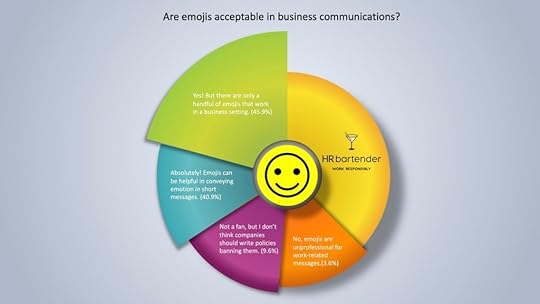
A few weeks ago, I asked for your thoughts on using emojis in work-related communications. It was just an informal poll. And the outcome was pretty one sided. You’ll see by the chart above, that emojis are fine. But there is a caveat: Emojis are fine if you use them properly.
I’m going to define properly as three things.
We know our audience. Fast Company just published an article about the collaboration platform Slack offering a new emoji pack that includes bunny slippers and a Dali-esque melting clock. Personally, I love them. But I could see how someone else might find them a little too cheeky for work. Just like email, tone doesn’t always come across with an emoji, so it’s important to understand how the recipient will receive it.The emoji being used is pretty well-defined. For example, we know what the “happy” emoji looks like . And we know what the “I’m cold” emoji looks like
. And we know what the “I’m cold” emoji looks like  . There are some emojis with a definition that may vary. I’ve seen more than one definition for the “palms together” emoji
. There are some emojis with a definition that may vary. I’ve seen more than one definition for the “palms together” emoji  . And there seems to be some question about how to communicate “laugh out loud” (aka LOL) via emoji.We recognize that the overuse of emojis could become annoying. A single emoji to acknowledge that you’ve read something is great. Or a couple of emojis to signal happiness, as in
. And there seems to be some question about how to communicate “laugh out loud” (aka LOL) via emoji.We recognize that the overuse of emojis could become annoying. A single emoji to acknowledge that you’ve read something is great. Or a couple of emojis to signal happiness, as in 

 to celebrate someone’s birthday or promotion might be awesome. But emojis are not a substitute for real communications.
to celebrate someone’s birthday or promotion might be awesome. But emojis are not a substitute for real communications.So, if you’re using emojis – please feel free to keep it up. But do take a moment to ask yourself, “Am I sure that I’m sending the right message?” And if you’re not using emojis, consider dropping one in occasionally. It might help you grow engagement as you make your point.
The post Emojis At Work Are Fine If Used Properly [poll results] appeared first on hr bartender.






June 15, 2021
How Organizations Can Build an Intentional Culture
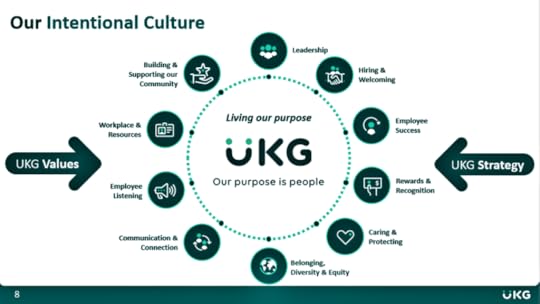
Estimated reading time: 6 minutes
(Editor’s Note: Today’s article is brought to you by our friends at UKG – Ultimate Kronos Group . Formed by two respective leaders in HR and workforce management solutions, UKG combines the strength and innovation of Ultimate Software and Kronos. They are committed to inspiring workforces and helping pave the way for their people, customers, and industry . Enjoy the article!)
A few weeks ago, I shared an interview with Dave Almeda about how Ultimate Software and Kronos unified their benefits plan post-merger to create UKG. During the interview, Dave mentioned the “10 Key Areas” that drive UKG culture. They are:
Leadership: Every employee deserves a great manager.Hiring and onboarding: UKG hires unique and smart people then sets them up for success.Performance and development: We hold ourselves accountable for delivering results.Rewarding, protecting and thanking: We seek employee feedback to continuously improve.Diversity, equity, inclusion and belonging: We foster an environment where everyone feels safe and welcome to bring their whole selves to work.Communications: We will communicate respectfully, transparently, inclusively, and easy.Celebration and community: We celebrate personal and professional achievement.Policies: We prioritize the care and safety of our employees.Workspace and tools: We trust employees to deliver no matter when or where they work.Corporate Social Responsibility (CSR) and giving: We give back to our community and encourage employees to do the same.I thought it would be great to do a follow-up with some insights about how UKG developed these key culture areas. I realize that not every organization is going through a big merger right now, but I thought the process of redefining organizational values and behaviors then using those to create an intentional culture could be exactly something for organizations to consider right now.
We all know that the past year has been tough. Organizations want to shift their focus toward economic recovery. And let’s be clear – economic recovery doesn’t necessarily mean “back to the pre-pandemic days”. Over the past year, organizations and employees have learned smarter ways to work, and those discoveries need to be incorporated into the business.
I had the opportunity to chat with Dave again recently for UKG’s Spring eSymposium. In fact, if you want to hear the conversation, you can listen to the archived session. Dave explained that UKG viewed the process of creating an intentional culture like building blocks. “We started by identifying the WHY, HOW, and WHAT of UKG. These three things keep us grounded and focused as an organization. It helps us create and maintain a common purpose, strategy, and goals.”

The first building block is “WHY”. WHY We Do What We Do. Whenever we talk about purpose and the “why”, I immediately think of Simon Sinek and his TED Talk about how leaders inspire action by understanding their why. UKG says that their “purpose is people”. And this purpose represents not only what they do externally in terms of providing human capital solutions but internally in the way they treat their employees.
The second block is “HOW”. HOW We Live Our Purpose. UKG identified three primary values and behaviors that shape their purpose – united, kind, and growing (another kind of UKG). United represents UKG employees working better together by being inclusive and collaborative. Kind means individuals treating each other with care and working to build trust. And growing shows that employees are agile and hold themselves accountable. You can see how these values and behaviors align with the first building block (WHY).
The third block is “WHAT”. WHAT We Do to Deliver on Our Promises. This, of course, is going to be different for every organization. One of the WHATs that UKG identified – and I think every organization can relate to – is “WOWing Customers and Keeping Them for Life”. Dave said that UKG actually thinks of customers more as partners for life. “If we do our job well, our customers will want to stay with us for as long as possible. We build strong customer relationships by investing in systems to deliver an exceptional experience, giving them a consistent experience, and staying humble. If we don’t do something right, we apologize and try to make it right.”
And of course, that brings us back to Dave’s comment in the benefits post about the 10 Key Areas that Drive UKG culture. First, UKG created their building blocks of WHY, HOW, and WHAT which defines the organizational values and behaviors that will drive their culture. Then, they used those drivers to build an employee benefits package.
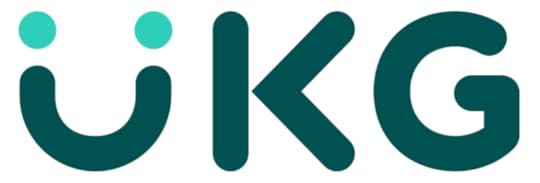
I really hope you’ll take a moment to listen to my conversation with Dave about how Kronos and Ultimate were able to build an intentional culture as UKG. One of the standout moments in the conversation for me was when Dave talked about the challenges of merging two “award winning” cultures.
“Oftentimes in a merger, one culture is clearly stronger than the other and naturally absorbs the ‘weaker’ of the two. Our merger is unprecedented as the first time in history that two Fortune 100 Best Companies to Work For have merged. With so much pride built-up in our respective former brands, our challenge was to honor key culture pillars that made each company so successful while simultaneously moving all our employees into a new culture, one that was unique to who we want to be as UKG and aligns with our future strategy.
We did this very thoughtfully and involved employees all along the way – from having a voice in choosing our new name, brand, and logo to building clear UKG values to rally around. While I’ve always been a believer in building an intentional culture, this last year-plus has truly been a case study for how this strategy can drive a more positive employee experience and subsequently, better business results – even in times of remarkable change.”
I think Dave is spot-on that building an intentional culture isn’t easy. But it’s necessary. Especially during times like these when organizations are using their culture as a way to attract, engage, and retain the best talent. If you’re looking for a real-life case study to offer some creative inspiration for your own efforts, keep in mind that the process UKG used works.
Identify the organization’s purpose.Agree on how the organization will reach its goals, along with what customers and employees should expect.Apply those building blocks to the key components of organizational culture. Then give managers the training and tools to support the organization’s culture.Now, I realize that I made all that sound really simple. The reality is, for organizations to get to the place where everyone is in agreement, it takes a lot of time and conversations. But getting everyone on the same page would be a great way to refocus toward economic recovery. It might be exactly the strategic activity that the organization needs right now.
The post How Organizations Can Build an Intentional Culture appeared first on hr bartender.






June 13, 2021
Onboarding for Individuals Changing Careers – Ask #HR Bartender
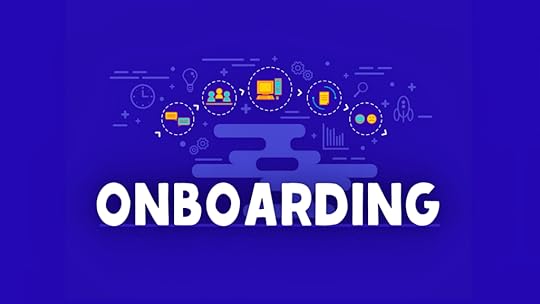
Estimated reading time: 3 minutes
Something we’re experiencing in today’s labor market are individuals pursuing a new career path. Today’s reader note asks about that topic.
Would you approach a new hire any differently if they were starting in a totally new career field? This is the situation that I’m in. I’m currently in the transportation industry and finishing my Masters in HR Administration.
I think this is a great question. For organizations that might be hiring individuals who are new to their industry or profession, I can see this being something they need to address. To me, the question becomes is this onboarding or training or both. Let’s look at a couple of definitions.
Onboarding is the process of integrating a new employee into the organization. It involves socialization and productivity. In the socialization part, onboarding should help an employee feel welcome and get to know the people they will be working with, including their manager. For the productivity piece, onboarding should help a new hire get the tools they need to be successful. This includes learning policies and procedures. It might also include training.
Training is the process of teaching a person a skill or behavior. To me, training is about teaching knowledge, skills, and abilities (KSAs) related to an employee’s current job. As a side note, development is focused on teaching the KSAs for future opportunities. As it relates to new hires, there could be topics that all employees will need training on (example: a proprietary software program) and there could be topics that only some employees need training on depending on their work experience and knowledge.
Back to the reader note. I could see a couple of different scenarios playing out:
The new employee attends company orientation and participates in onboarding with their department. During onboarding, the new hire is exposed to the new experiences and training they need to be a successful contributor. The training could be on-the-job, self-paced, or with a buddy or mentor.The new employee attends orientation. Then, depending on the organization, they attend an in-depth training and development program. For example, the new employee participates in a leadership and management program immediately following orientation. The leadership and management program could be internal or external.How the organization develops the onboarding plan could be based on many factors including the size of the organization, the bandwidth of their learning and development department, and the KSAs of the new hire.
We’re seeing an increasing amount of talk about the labor market and how tough it is to find qualified candidates. It’s very possible probable that organizations might have to interview and hire candidates who do not have all the experience or all the skills. And then make a promise to help that candidate get the experience and skills. The way to do that is with an onboarding and training plan.
Cover art: Lauby, Sharlyn. A Roadmap for Onboarding Managers TD at Work, ATD Press, 2018
The post Onboarding for Individuals Changing Careers – Ask #HR Bartender appeared first on hr bartender.






June 9, 2021
Successful Recruitment Means Being Responsive to Candidate Schedules
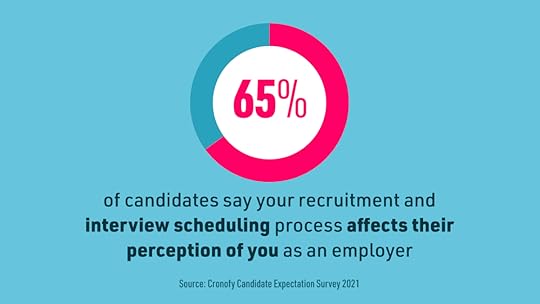
(Editor’s Note: Today’s article is brought to you by our friends at Cronofy , a global innovator in business scheduling software. It provides businesses with the technology they need to offer best-in-class interview scheduling. Enjoy the read!)
Regular readers of HR Bartender know that I used to work at an airline. And one of my responsibilities was recruitment. So I found it interesting to see an article recently about Delta Airlines having to cancel 100 flights because the airline was struggling with staffing.
It reminded me of a comment that a senior vice president made to me years ago when I was responsible for airline recruitment. “You don’t want to be the reason that a plane doesn’t take off.” Organizations rely heavily on recruitment because they need employees to deliver their products and services. There is a direct connection between being properly staffed and the bottom-line.
And to clarify, this situation with Delta isn’t unique. I’ve seen articles about labor shortages in restaurants, hospitality, manufacturing facilities, etc. I’m sure you’ve seen them too. It emphasizes the fact that organizations cannot afford to take a ‘wait and see’ approach when it comes to recruitment and economic recovery. They need to put their plans in place now, so they can attract the best talent for the business.
It also means organizations need to have a recruitment process that applicants and candidates want to be a part of. The labor market is quickly shifting toward the candidate – if it’s not there already – and organizations need to understand candidate expectations, particularly for senior roles or industries where talent is scarcer.
What Do Candidates ExpectOur friends at Cronofy recently published their 2021 Candidate Expectations Survey and I thought the results were fascinating. Almost 50% of applicants said that responsiveness is the number one priority in hiring. This wasn’t a surprise to me (and it shouldn’t be to you either).
I’ve mentioned before that the number one comment that I get from readers is about recruiter responsiveness. Specifically, that recruiters don’t follow-up with candidates. That lack of responsiveness – especially when it comes to scheduling interviews – has an impact on the organization’s brand and the company’s ability to hire the best talent. The survey backed this up by sharing that 51% of candidates have left (maybe a better word is ghosted?) a recruitment process because they were frustrated with the time it took to schedule an interview.
Some of you might be saying to yourself, “Well, what do candidates expect? What’s a reasonable response time?” It’s a valid question. According to the Cronofy survey, most candidates (40%) expect their wait to be between 2-6 days between applying and scheduling the interview. That’s less than a week. Many more expected an interview within 24 hours. And it’s great that we now have actual data that we can use to understand that.
I know HR departments and hiring managers are busy, but this is good data to share within your organization. Maybe during the recruiting strategy meeting (aka the intake interview), take time to talk about the recruitment timetable. I’m not saying that a week is absolutely necessary. You have to do what works for your organization. However, recruiters and hiring managers should also discuss the consequences of not meeting a candidate’s expectations.
Another data point worth noting: After a week, 35% of applicants have a negative impression of the organization because it took so long to schedule an interview. After two weeks, 61% would disengage with the organization. This data is consistent across ages, genders, and positions. Don’t forget that famous case study about Virgin Media and how a bad candidate experience cost the company $5M annually.
The good news is that organizations can put some of a candidate’s expectations around responsiveness into their own hands. Technology can help time-strapped recruiters to deliver the recruitment experience which feels and is representative of working for your company. Cronofy Scheduler is just one example of this, it allows organizations to invite candidates to an interview using all the required people’s availability. Once the invite is sent, the candidate can choose the date and time that works for them. This allows the organization to actually eliminate tons of back-and-forth. The interview scheduling process – which is often the most difficult for both recruiter and candidate – happens much faster. It feels less chaotic and reduces recruitment administration and time to hire. Crucially though – it’s something that can massively impact perceptions of your employer brand if it’s done badly. Done well, it’s an efficient and less stressful experience for all parties. Done badly, and candidates are taking away a negative perception of what it is like to work for your company.

It’s also an activity that candidates are willing to be a part of. Over 50% of applicants prefer scheduling an interview using technology such as email, text, and/or social media. Being able to empower candidates to choose the time that suits them best is a huge step forward and there’s evidence that it reduces no shows, something we know 90% of companies experience. Who wants to feel shoehorned into a time that doesn’t really work for them? That doesn’t make someone feel valued or important. It’s also a part of the process which candidates don’t need to be privy to – the challenge of coordinating two or more hiring managers’ calendars is all too often relayed over the phone. That doesn’t add value to the hiring experience. All it communicates is that the place is really busy, they have a lot of meetings, possibly that they don’t prioritize hiring. It should be and can be seamless.
Responsiveness Wins with CandidatesRecruitment is a hot topic right now – and it should be! Organizations have to start taking a proactive approach to finding and engaging applicants and candidates. There are many things impacting hiring post-pandemic but what’s clear is that, in this more competitive landscape, the experience matters, if possible, even more than before! People will only move if they’re sure they will be valued, and the changes that have happened recently mean that investing in your hiring process to improve your employer brand is a no-brainer. 48% of candidates would be less likely to recommend or engage with an employer in the future, based on frustrating interview scheduling experience, rising to 64% with more senior roles. That means understanding what frustrates candidates and being in a position to mitigate those frustrations. It only makes sense – candidates who are frustrated with an organization won’t want to work for them.
If you want to learn more about creating a great candidate experience, join me and Cronofy CEO Adam Bird on Thursday, June 24, 2021 at 10:30 am Eastern for a webinar on “Get candidates insights to improve processes and hire the best talent to grow”. We’ll discuss the results and how to use them to improve your hiring processes. We’d love to see you there. Oh, and if you’re already committed – no worries – just sign up and get the recording.
The results in this article are just some of the great insights you can glean from the Cronofy 2021 Candidate Expectations Survey. Trust me, you’ll want to download the full report.
The post Successful Recruitment Means Being Responsive to Candidate Schedules appeared first on hr bartender.






June 6, 2021
How Recruiters and Job Seekers Can Successfully Connect on LinkedIn
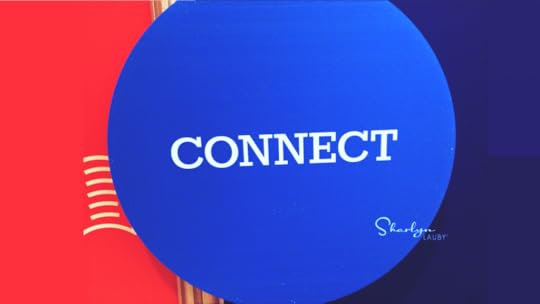
Estimated reading time: 6 minutes
LinkedIn is the world’s largest professional networking site with almost 800 million members in more than 200 countries and territories. And while there are other social networking sites out there, none of them have the work-related focus of LinkedIn. So, I do believe that working people should have a LinkedIn profile and keep it current.
There are thousands of articles on the internet about how to maintain your LinkedIn profile. This article from The Muse on “9 Surefire Ways to Boost Your LinkedIn Profile When You Only Have 10 Minutes” is worth taking a look at. But one of the aspects of staying active on LinkedIn that we don’t talk about nearly enough is making connections. Specifically, how to engage with someone – recruiter or job seeker – about a job opportunity.
To help us understand more about successfully engaging on LinkedIn, I asked a friend and colleague of mine for help. Thankfully, she said yes. Kristina Minyard is the founder and CEO of HRecruit LLC in Alabama. The consultancy offers direct placement services and recruitment training to help organizations with their talent strategies.
Kristina, thanks so much for being here. I know one of the biggest challenges being discussed right now is that organizations are having difficulty finding qualified candidates. As a result, recruiters are looking for passive candidates and one of the first places they may go to is LinkedIn. Can you offer 1-2 pieces of advice to recruiters who are trying to start a conversation with a passive candidate?

[Minyard] Two things: First, be honest, specific, and to the point. Avoid ‘I came across your profile and you look like a good fit for a role I’m recruiting for’ type phrases. Instead try: ‘I’m looking for a skilled data scientist and your profile stood out to me because XX experience is exactly what someone would’ve done recently to prepare for this role with us.’
Second, personalize your message. Take a minute to learn something about the candidate before you craft your message. If you’re using an upgraded version of LinkedIn that gives you a suggested message to send – your message is not going to stand out. Chances are you are not the only person firing off that standard message to a candidate and it’s going to get overlooked for a reply.
So maybe your perfect data scientist candidate has noted on their profile that they are passionate about volunteering at their local animal shelter. Maybe they are also serving on a data and AI ethics committee. You can easily use either of these points to personalize your message and show them that you reviewed their full profile, not just their most recent role. Personally, I’m going to point out the data and AI ethics committee role. Here’s what I might say: ‘I notice you’re currently serving on data and AI ethics committee XX. This is really cool and shows that you probably care just as much about ethical data decisions as we do.’
If a recruiter receives a connection request directly from a job seeker, should they accept it? What are the advantages and disadvantages to doing so?
[Minyard] I typically review the industry that the job seeker is in, and if it’s a match for what I recruit for then I’ll go ahead and accept it. If it’s an industry that I can’t help them with I usually decline their connection request.
Advantages to accepting: You are growing your audience. If you are pushing regular content out, you want that to be in front of your target audience. By being selective of who you connect with, you can make sure that’s what’s happening. For every connection you add, you increase your 2nd and 3rd connections as well, making more talent easier to get in contact with.
Disadvantages to accepting: If you accept talent who you can’t help, you may end up spending time corresponding with them anyway (if you’re like me and respond to everyone). Just like recruiters sometimes do, candidates will end up sending a generic message to every recruiter they connect with and then you find yourself taking time to respond appropriately and let them know you don’t have anything for that skillset.
Let’s flip the focus to the job seeker. As a follow-up to last question: Should a job seeker read anything into a recruiter’s reply for a connection request? Meaning if a recruiter accepts it, that’s good. And if they decline, that’s not so good. Why or why not?
[Minyard] Definitely do not read anything into it. An acceptance does not necessarily mean they are interested in presenting you as a candidate and a decline doesn’t necessarily mean the opposite. Everyone has their own preferences on how they handle growing or protecting their online network and without actual feedback on why a recruiter chose to connect or not, you’ll only drive yourself crazy trying to read into it.
If a LinkedIn user isn’t currently interested in a new opportunity, should they accept a connection request from a recruiter? Is that sending the wrong message?
[Minyard] There’s nothing wrong with connecting to recruiters before you’re ready to make a move. In real life, we network with connections before we have a need, that can carry into online networking as well. Candidates should determine if this is someone that they want to have access to or someone they want to have access to them.
Most recruiters aren’t reading into a connection, they will use a conversation to determine mutual interest and the best path forward. If a candidate is concerned about sending the wrong message through accepting a connection request they can simply say “I’m not interested in making a move right now, but I am interested in staying in touch for when that changes.”

Last question. LinkedIn allows users to follow organizations. What are the advantages and disadvantages of doing so?
[Minyard] Following an organization allows you to see what kind of content they are sharing in their industry. It can be an easy way to keep an eye on a company who you think is doing interesting work or one you might be interested in considering as a future employer. If they are sharing content that is interesting to you, engaging in conversation in the comments is an easy way for you to show your interest and expertise to that organization. Make sure you limit yourself to meaningful comments and not repetitive or one-word comments just to show up in their notifications.
Of course, the disadvantages could be that you learn things you don’t like about an organization, or they fill your newsfeed with spam-like updates. If that becomes the case, you can simply unfollow them!
I want to extend a HUGE thanks to Kristina for sharing her expertise with us. If you want to learn more from Kristina, be sure to follow her blog and connect with her on Instagram.
Whether you’re a recruiter or a job seeker (or both!), it’s important to know LinkedIn and use it well. I believe Kristina’s message about personalization and being yourself is spot on. Because organizations and individuals want the same thing – to be themselves.
The post How Recruiters and Job Seekers Can Successfully Connect on LinkedIn appeared first on hr bartender.






Sharlyn J. Lauby's Blog
- Sharlyn J. Lauby's profile
- 10 followers



